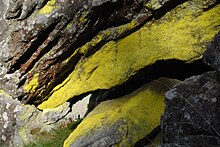| Chrysothrix chlorina | |
|---|---|

| |
| Scientific classification | |
| Domain: | Eukaryota |
| Kingdom: | Fungi |
| Division: | Ascomycota |
| Class: | Arthoniomycetes |
| Order: | Arthoniales |
| Family: | Chrysotrichaceae |
| Genus: | Chrysothrix |
| Species: | C. chlorina
|
| Binomial name | |
| Chrysothrix chlorina (Ach.) J.R.Laundon (1981)
| |
| Synonyms[1][2] | |
|
List
| |
Chrysothrix chlorina, the sulphur dust lichen, is a species of leprose (powdery) crustose lichen in the family Chrysotrichaceae.[3] Originally described scientifically by the Swedish lichenologist Erik Acharius over 200 years ago, it has been shuffled to many different genera in its taxonomic history before finally being transferred to Chrysothrix in 1981. The lichen has a circumboreal distribution, meaning it occurs in northern boreal regions across the planet. It is typically saxicolous (rock-dwelling), particularly on the underside of rock overhangs, but has in rare instances been recorded growing on bark and various other surfaces.
The lichen thallus is a yellow to yellow-green layer of fungi and green algae that are bundled together in powdery clumps called soredia. It lacks apothecia and pycnidia, which are reproductive structures found in many other lichens. Chrysothrix chlorina resembles several other lichen species but can be differentiated based on chemical composition and morphological characteristics. Historical confusions and misidentifications have occurred, especially with species such as Chrysothrix candelaris and Psilolechia lucida. In India, Chrysothrix chlorina is used for dyeing, and 19th-century studies in Sweden revealed it could be used to produce 14 distinct colours.